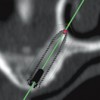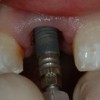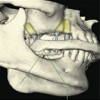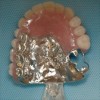The work of the pioneers in complete denture prosthodontics laid the groundwork for modern esthetic dentistry. Anterior tooth size, shape, and color and arrangement effect not only the esthetic display but also play an important role in articulation of specific speech sounds. This program illustrates the methods used to select and arrange anterior denture teeth to provide a natural and pleasing appearance that fits the personality of the patient and enables normal articulate speech.
Complete Dentures» Next Lecture› [next_page]
Complete Dentures – Anterior Tooth Selection — Course Transcript
- 1. 11. Anterior Tooth Selection Eleni Roumanas DDS Division of Advanced Prosthodontics, Biomaterials and Hospital Dentistry UCLA School of Dentistry and Frank Lauciello DDS Ivoclar Vivadent This program of instruction is protected by copyright ©. No portion of this program of instruction may be reproduced, recorded or transferred by any means electronic, digital, photographic, mechanical etc., or by any information storage or retrieval system, without prior permission.
- 2. Anterior teeth are primarily selected to satisfy esthetic requirements Posterior teeth are primarily selected to satisfy masticatory requirements/ occlusion Anterior Tooth Selection
- 3. Morphology(Mold) Size Color Tooth Placement There are no rules of thumb; however there are anatomic landmarks and manufactures aids that can be used as guides . Anterior Tooth Selection
- 4. Guides Preextraction records – photos , diagnostic casts , old x-rays Postextraction records – existing dentures ie tooth size, placement, shade, VDO, occlusal plane Pts. facial characteristics , arch size Pt. preferences Anterior Tooth Selection
- 5. Careful evaluation of existing dentures Patient’s perception of their appearance. Your perception of the esthetic needs of the patient.
- 6. Dentogenics/Dynesthetic concepts of Fisher and Frusch : They integrated the selection of teeth into an esthetic system governed by the age , sex and personality of the pt . a) Sex: male – rugged with square teeth & bold central incisors female – pronounced curvatures, rounded point angles b) Personality: vigorous or delicate “ Personality tooth ”-the maxillary lateral incisors vary more in size, form and position than any other tooth c) Age: Young – tapered, ovoid, rounded teeth Middle Old – square, sharp corners Tooth Form/Mold:
- 7. Delicate Rounded arch form Rounded tooth corners Anteriors closely follow the lower lip Laterals overlap centrals Smaller laterals and cuspids Sharp canines Delicate vs Rugged Characteristics:
- 8. There are no hard and fast rules. Square arch (unexpected in females) Diastema Moderate tooth wear Staining Gingival recession Natural Dentition- Female
- 9. Delicate vs Rugged Characteristics: Rugged Angular outlines Larger laterals and canines Square arch form Centrals overlap laterals Blunt canines
- 10. Square arch Square centrals Rounded laterals in labioversion( considered a female characteristic) Crowding Gingival recession Natural Dentition- Male
- 11. Must harmonize with face and arch size Any disproportion in arch size influences the length, width and position of the teeth Vertical distance between the ridges- use a tooth long enough to minimize the display of the denture base Mark high lip line and canine lines on the occlusion rim at the time the jaw relations are recorded. These guide lines provide information about the gingivoincisal length and total mesiodistal width of the maxillary six anterior teeth Size Of Anterior Teeth
- 12. Shape and contour the wax rim so that it mimics the shape and contours of the finished denture with the anterior teeth. The wax rim should extend 1-2 mm below the lip line. Mark the canine line at the corner of the lips and measure the distance with a flexible ruler Size of the Anterior Teeth
- 13. Ivoclar-Vivadent Facial Meter Size of the Anterior Teeth In the majority of pts., a relationship exists between the inner canthus measurement and the distance between distals of the maxillary laterals. This measurement can then be carried directly to select the proper maxillary anterior teeth.
- 14. – two principal colors are yellow and gray -harmony between the color of the skin, hair & eyes Guides Complexion Hair color Eye color Age Personality & activity Patient desires Need to educate pts. Color Or Shade Of Anterior Teeth
- 15. Color Or Shade Of Anterior Teeth The Chromascop ® is the shade standard for the Ivoclar Vivadent Product lines including IPS Empress, IPS design, composite restorative Materials etc. Shade Comparison Chart A-D Shade A1 A2 A3 A3.5 A4 B1 B2 B3 B4 C1 C2 C3 C4 D2 D3 D4 Chromascop 120 130 210 230 340 110 040 130 210 310 — 430 510 — — 420 —
- 16. Color Or Shade Of Anterior Teeth Check the shade of the pts. existing denture and discuss their desires with respect to the tooth shade. Would they prefer the same shade, a shade that is lighter or darker. Place the guide up against the pts. face and select a shade that blends with their skin tone, hair color and sclera/eye color. Once you have selected a color allow the pt. view it against their lip with a mirror and give their approval.
- 17. – positioned in the same general area on the natural teeth -this position was tentatively established during the clinical refinement of the maxillary occlusal rim to provide adequate lip support and proper phonetics -used to its maximum potential when accomplished at chairside -the arrangement has to fulfill certain biomechanical needs as well as esthetic ones Placement of Maxillary Anterior Teeth
- 18. Considerations: Midline Lip support Vermilion border Phonetics- f, v, s sounds Buccal corridor Canine eminance- arch type, square, tapered, ovoid Incisal papilla- to labial of central incisor 8-10 mm Vertical and horizontal overlap- 1.5 mm Generally 1-2 mm of the incisal portion of the maxillary central incisor is visible below the relaxed lip Smile line- follow contour of lower lip Occlusal Plane Anterior Tooth Placement
- 19. Anterior teeth should not be placed directly over the ridge Anterior Maxilla Following extraction, resorption is from buccal-labial towards the lingual. Anterior Tooth Placement
- 20. Incisal length Almagauge Anterior Tooth Placement The incisal length and width can be measured with the use of the Almagauge.
- 21. Labial incisal distance- This is generally 8-9 mm anterior to the incisive papilla. Anterior Tooth Placement
- 22. Anterior Tooth Placement The measurements can them be used to help guide the initial contour of the wax rim.
- 23. Average Value Positions Labial incisal position Female Young 8 Middle 7 Old 6 Male Young 6 Middle 5 Old 4 Incisal length is on the average 22mm from the labial sulcus
- 24. Patient Factors: Lip Length vs. Incisal Display Sex & Age Female Male Young +2 +1 Middle +1 0 Old 0 -1 Vig, JPD 1978 Lip Length Incisal Display 10-20mm 3-4mm 20-25mm 2mm 26-30mm 1mm 30 & over 0
- 25. follow contour of lower lip avoid reverse smile line young female has greater curvature of smile line older males have less curvature of smile line Male Female Reverse curve Greater curvature Lesser curvature Smile Line
- 26. Papillameter Determining The Smile Line Using the OPA ruler or Papillameter place the flat end inside the mouth and up against the incisal papilla, the lower lip line can be recorded at rest position and the high lip is recorded during a smile. Communicating this information to the laboratory aids in the esthetic arrangement of the maxillary anterior teeth.
- 27. – the anterior teeth and tongue act as a part of the valving mechanism which modify the flow of air to produce speech sounds Labial sounds: “p” “b” -if the lips are not supported properly by the teeth these sounds may be defective Labiodental sounds: “f” “v” -are produced by contact between the maxillary incisors and the posterior one-third of the lower lip Linguodental sounds: “th” -are produced by extending the tip of the tongue 3-6 mm beyond the incisal edges of the upper & lower anterior teeth Phonetic Considerations
- 28. esthetics phonetics Anterior Tooth Placement: “ F” and “V” Sounds The upper lip contacts the the wet-dry line of the lower lip during speech production of “f” and “v” sounds.
- 29. Linguopalatal sounds: “s” -the “s” sound is made by contact between the tip of the tongue and the palate at the rugae area with a small space for the escape of air – if the space is too small a whistle usually results and if the space is too broad an thin, the “s” sound is replaced by th “sh” sound which sounds like a lisp Phonetic Considerations
- 30. Material Considerations Avoid mismatching of materials For example: Porcelain anterior teeth combined with acrylic resin posterior teeth. Why? Excessive wear of the posterior teeth leads to occlusal discrepancies, tipping of the dentures anteriorly and resorption of the alveolar ridge.
- 31. Ivoclar Denture Tooth Molds
- 32. Ivoclar Denture Tooth Molds “ the ideal artificial tooth should be a reflection of its natural model” Ivoclar anterior moulds are based on an analysis of natural anterior teeth. They correspond to natural teeth in appearance, anatomy and function. They are purposely asymmetrical from one side of the arch to the other for a more natural appearance .
- 33. Ivoclar Denture Tooth Molds Ivoclar anterior teeth are catagorized into square, tapering and ovoid shapes. Square Tooth Molds: With this angular shape, the central incisor is dominant and the gingivo-incisal curvature is moderate. The square facial shape offers maximum light deflection and creates a bold effect. Tapering: Characterized by rounded contours which taper towards the cervical ridge. Moderate gingivo-incisal curvature. Large triangular incisor slightly triangular in shape. Ovoid: The teeth have a pronounced gingivo-incisal curvature, which tends to disperse the light reflection and create a softened appearance.
- 34. Interproximal embrasures The proximal contact points of Ivoclar teeth are in the same position as in their natural counterparts. They are placed in the incisal third instead of the mesial edge which helps to individualize each tooth. Ivoclar Denture Tooth Molds
- 35. Mesial incisal line angle “bold” Ivoclar Denture Tooth Molds “ the ideal artificial tooth should be a reflection of its natural model”
- 36. “ the ideal artificial tooth should be a reflection of its natural model” Height of contour Ivoclar Denture Tooth Molds
- 37. Distinct cervical margin Ivoclar Denture Tooth Molds “ the ideal artificial tooth should be a reflection of its natural model ”
- 38. “ the ideal artificial tooth should be a reflection of its natural model ” Mandibular incisal edge wear Ivoclar Denture Tooth Molds
- 39. The End!


 Prosthodontic Procedures and Complications
Prosthodontic Procedures and Complications
 Single Tooth Defects in Posterior Quadrants
Single Tooth Defects in Posterior Quadrants
 Angled Implants
Angled Implants
 Implants and RPDs
Implants and RPDs
